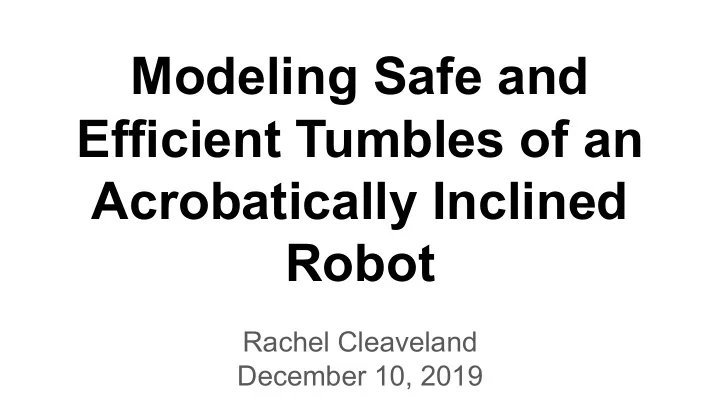

Modeling Safe and Efficient Tumbles of an Acrobatically Inclined Robot Rachel Cleaveland December 10, 2019
October 19th, 2019 - Simone Biles takes the world record for the most medals won by a single gymnast at the world championships
The System - Scenario : a robot wants to safely perform a tumble with flips and twists - Initial considerations : Bounce off of the floor - - Speed of rotation - Safety condition : Feet-first landing - Forward of backwards -facing - landing
Modeling Challenges 1. Once rotation has started, it cannot stopped Gymnasts adjust moment of inertia ○ to adjust angular velocity No fallback option in the controller ○ 2. Circular motion of flips and twists Difficult to adequately predict the ○ future location of the robot in controller KeYmaera X does not support ○ trigonometric functions
Three Aspects of Motion Parabolic Flipping Twisting Combined
The Model: Abstractions and Simplifications 1. Separate pieces of motion a. Independent generation and control 2. Representation of flips and twists with circular motion 3. Control robot’s angular velocity with radius
The Model: Preconditions - Robot given a positive amount of time until it returns to the ground ( timeToGround ) - Flip radius falls in range [ minflipr , maxflipr ] - Twist radius falls in range [ mintwistr , maxtwistr ] - pull and wrap are positive, give linear velocity of flips and twists - Robot initially facing forwards and in an upright position flipy = flipr, flipx = 0, twisty = twistr, - twistx = 0
The Model: ODEs Differential equations : derivative of parametric equations of a circle Evolution domain constraint : timeToGround is at least 0 t is either 0 , or twistx not equal 0 , or flipy not equal flipr
The Model: Controller maxflipr ● Initial choice: robot may not start twisting or flipping at all ● Compute Flips that can be completed with ○ minflipr minflipr in timeToGround time Flips that can be completed with ○ maxflipr in timeToGround time ● If one additional flip can be done with minflipr than maxflipr , flipping is safe Set flipv to pull ○ Else set flipv to 0 ○
The Model: Controller Before the ODEs : nondeterministically assign a value to flipr in range [ minflipr , maxflipr ] Check that flipr is safe by using a Taylor series approximation for the value of flipy after timeToGround time.
The Model: Invariants and Postcondition Loop Invariant & Postcondition: if timeToGround is 0, then the robot’s position should be within approximately a 45 degree angle of being perfectly upright, and it should be within a 45 degree angle of facing perfectly forwards or backwards. Simple loop invariant = weaker preconditions for proving each loop iteration Solution: introducing more vacuous behavior in the controller
Proof Outline: Safety Want to prove : after any run of the system, when timeToGround is 0, flipy is at least 0.7*flipr , and twisty is at least 0.7*twistr or at most -0.7*twistr 1. Four cases : a. Neither flip nor twist b. Flip but not twist c. Twist but not flip d. Both flip and twist 2. Apply the loop invariant a. Non-flipping, non-twisting case is trivial to prove i. Robot leaves the ground in a favorable landing position
Proof Outline: Safety 3. Flipping or twisting cases: use the Taylor series approximation Differential For all times cut For timeToGround Controller time When timeToGround - t = 0 ( t = timeToGround) , the Taylor series approximation being at least 0.7*flipr implies flipy is at least 0.7*flipr . 4. Closes through a series of differential cuts and differential invariants
Proof Outline: Taylor Series Approximation In model Realistic upper bound Taylor series approximation to
Proof Outline: Liveness Convergence Lemma Robot starts from upright position Exists a flipr in [ minflipr , maxflipr ] A whole number of flips are done in timeToGround time with radius flipr
The Proof: Model Improvements Identified sources of vacuous behavior in the model - Resulting from use of Taylor series approximation Fixes: - Separate flipping and twisting models
Outcomes and Contributions Outcomes - Safety proof for model of robot that performs flips or twists Made use of Taylor series approximations - Contributions - Field of self-righting robots
Future Work - Stalling: give the robot the option to start flipping later if it initially chose not to - Falling robots: Already falling with some initial - rotation Do not have the option not to - flip initially
Summary - Problem: wanted to prove that a robot can perform flips and twists and always land safely - Approach: - Use timeToGround to abstract away parabolic motion - Use circular motion to model flips and twists - Controller chooses a flipr based on the robot’s estimated position in timeToGround time - Outcome: - Proof of safety of controller for a robot that performs flips or twists
Acknowledgements I would like to thank Dr. Andre Platzer, whose insights on the Taylor series approximations as well as the undecidability of first order logic of the natural numbers gave me great direction throughout this project. I would also like to thank Katherine Cordwell, also helped to direct this project in a better path. Also, major thanks to Yong Kiam Tan, whose knowledge of proof techniques and KeYmaera X allowed me to close the proof, and to Stefan Mitsch for his additional knowledge of KeYmaera X.
Recommend
More recommend